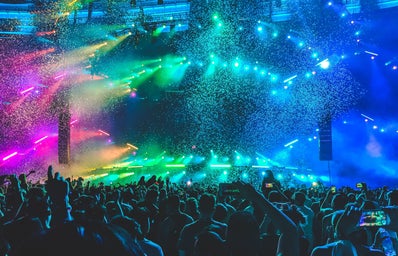Harry Potter is a cultural phenomenon. From a story scrawled on napkins in cafés, it spawned seven books, nine movies (not counting the upcoming Fantastic Beasts movie), a theme park attraction, a spin-off play, a parody play, and a generation of people who proudly refer to themselves as “Potterheads.”
You’d think that’d be enough for author J. K. Rowling to wipe her hands, step back, and enjoy retirement with the billions of dollars that the franchise has brought her.
Sadly, it’s not. She’s become notorious for trying to retroactively add diversity to her books in ways that range from baffling to offensive and racist.
In 2007, during a question and answer session at Carnegie Hall in New York City, Rowling informed fans that Albus Dumbledore, Harry’s mentor, had always been gay.
That was a good thing, right? Finally some representation for gay people, in a series that had been entirely composed of straight characters until that point?
Well, just because the representation is there doesn’t mean that it’s good.
Dumbledore was never mentioned or shown to be in a relationship with a man in the books. Not once, not even a passing mention of an old boyfriend. You could chalk it up to Dumbledore being as secretive as he was, but here’s a good rule of thumb: it’s not good representation if it’s only mentioned outside of the canon content. Saying “oh, he was gay, but it was never mentioned because it didn’t matter to his story” is not good representation. It’s a part of his identity. It’s part of who he is. Of course his sexuality is important to his story and his character. There’s no reason to leave it out of the story completely.
The same goes for Hermione Granger. Her race was never outright stated in the books, and fans have interpreted her as black for a long time. In 2015, black actress Noma Dumezweni was cast as Hermione for the spin-off play Harry Potter and the Cursed Child. After backlash, Rowling took to Twitter to defend the casting choice, stating that the character could be read as black in the books.
It’s not the casting choice that bothers me. I’m always happy to see traditionally white characters reinterpreted to be another race, and I love the concept of black Hermione. It’s Rowling’s response that bothers me.
We know that Dean Thomas was black. We know that Alicia Spinnet and Lee Jordan and Angelina Johnson were black. They were described as having dark skin and dark hair. We didn’t know with Hermione. Again, her race was never stated outright. She was said to have brown eyes and lots of bushy hair. Rowling had seven very long books to tell us Hermione’s race, but only now are we hearing about it. I do not believe that Rowling wrote Hermione with a black girl in mind. She hitched onto the diversity train years afterwards to try to earn some points.
Where’s my proof? Look at the main Harry Potter movies. Rowling had final approval on the script and director of each movie and insisted on an all-British cast. She even served as executive producer for both Deathly Hallows films. She clearly had immense creative control over the movies. So, why, then, was Hermione played by Emma Watson, a white woman? If Rowling truly believed that Hermione was black, she could have insisted on a black actress. Or, if I’m wrong, and she did write her as black from the beginning, then she was happy to let a white actress play a black character.
See the problem? Either way, it’s not good.
And now, there’s the problem of Nagini.
If you don’t remember (or never read the books and don’t know), Nagini was Voldemort’s pet snake. She was also one his Horcruxes (i.e. contained a part of his soul), and her death—or, more accurately, the destruction of the Horcrux—allowed Voldemort’s eventual defeat.
Last year, the main cast for the upcoming movie Fantastic Beasts: The Crimes of Grindelwald was released on the Pottermore website. As is a staple for the Harry Potter movies, the cast was mostly white, with Zoë Kravitz and Claudia Kim as the only actors of color. They all had names—except for Kim’s character.
Her official description on Pottermore was as follows: “Claudia Kim appears as a Maledictus, the carrier of a blood curse that destines her ultimately to transform into a beast.” Other information released identified her as a “circus attraction.”
That rubbed some people the wrong way. The fact that one of the only Asian characters in the entire Harry Potter franchise was going to be an unnamed circus attraction who would ultimately turn into a “beast” is racist. There’s no way around that.
A few weeks ago, Kim finally announced her character’s name.
Nagini.
That’s right. Nagini the snake is actually a person. Because she was a Maledictus, the character would end up transforming into a snake that would later come to be Voldemort’s pet. She was milked for her venom to use in a potion to help Voldemort sustain a weak physical form after his first defeat.
So, Voldemort—the Nazi metaphor—kept a Korean woman as a pet. He forced her to become a Horcrux and share part of his soul. And, if you think about it, the heroes’ victory depended on the death of an enslaved Korean woman.
You see why that’s not great?
On Twitter, Rowling defended the plot point by tweeting the following:
That’s great, but Claudia Kim is South Korean. Koreans weren’t even a large ethnic group in Indonesia until recently. Fantastic Beasts: The Crimes of Grindelwald is set in the 1920s.
If we want to dig deeper into this, a quick Google search reveals that the Naga are not strictly Indonesian; rather, the myth originated in India in Hinduism, Buddhism, and Jainism, and were brought into other countries, such as Indonesia, as the religions spread. Though Buddhism became a major religion in Korea, the Naga did not go with it. They’re more associated with South and Southeast Asia.
A word of advice, Rowling. If you’re going to steal myths from other parts of the world for your movies, at least cast a person from that part of the world. South Korea and Indonesia aren’t even remotely in the same area of Asia. I’m not saying she thinks all Asians are interchangeable with each other, but, well, I think that’s what I’m saying.
Rowling’s attempts at diversity have all fallen flat. They feel forced and downright offensive at times. It’s clear that she has no intention of making her stories inclusive in a respectful way. If she truly wanted to write a minority character, she would give them a prominent role and make it clear within the story—not in a tweet eight years later—that they are that minority. No, Rowling just wants those diversity points.
She needs to stop.



